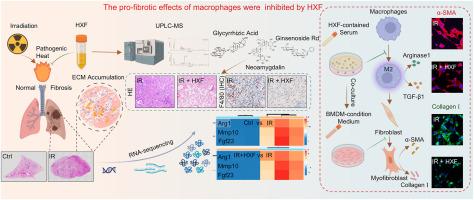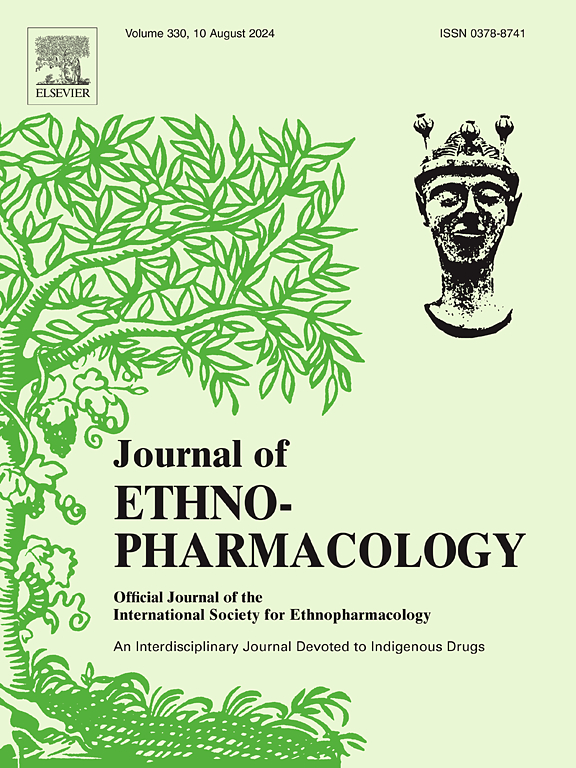化仙方通过抑制巨噬细胞的促纤维化作用防止辐射诱导的肺纤维化进展
IF 4.8
2区 医学
Q1 CHEMISTRY, MEDICINAL
引用次数: 0
摘要
民族药理学意义:华仙方(HXF)是一种传统中药,专门针对辐射诱导的肺纤维化(RIPF)中由辐射诱导的 "热毒 "和 "痰瘀 "病理因素。它通过清热活血,解决了 RIPF 发病的这些关键因素:研究目的:HXF 在预防 RIPF 方面具有潜力,但其潜在机制仍不清楚。本研究旨在探讨 HXF 的功效、分子靶点和作用机制:通过超高效液相色谱和串联质谱(UPLC-MS)鉴定 HXF 的主要成分。将 C57BL/6j 小鼠分为四组:对照组(Ctrl)、单用 HXF 组(HXF)、单用 17Gy 照射组(IR)和照射加 HXF 组(IR + HXF)。组织病理学染色评估肺损伤和肺纤维化,流式细胞术和免疫组织化学(IHC)检测辐照后16周体内肺组织的巨噬细胞表型。转录组测序和生物信息学分析确定了受 HXF 影响的关键基因。体外实验包括流式细胞术、western bolt和定量PCR(qPCR),探讨了HXF对巨噬细胞极化和纤维化活性的影响,而巨噬细胞条件培养基与小鼠胚胎成纤维细胞NIH/3T3的共培养实验则研究了巨噬细胞与成纤维细胞之间的相互作用。体内研究结果表明,IR 组的肺损伤和纤维化显著,而 IR + HXF 组的肺损伤和纤维化明显减轻。HXF还能显著抑制肺组织中M2型巨噬细胞的浸润。转录组分析发现了差异表达基因(DEGs),如 Arg1、Mmp10 和 Fgf23。生物信息学富集分析表明,这些 DEGs 参与了与抑制细胞外基质形成和炎症有关的通路。在体外,含HXF的血清可降低M2型巨噬细胞的极化,并减少精氨酸酶1和TGFβ1的分泌。经 HXF 处理的巨噬细胞的条件培养基可抑制成纤维细胞的活化:结论:HXF 对 RIPF 的预防作用涉及多个靶点和机制,包括调节 Arg1、Mmp10 和 Fgf23 的表达。通过抑制巨噬细胞的促纤维化能力,HXF 可抑制成纤维细胞的活化和胶原蛋白的产生,从而缓解肺纤维化。这些发现强调了 HXF 作为一种管理 RIPF 的预防性策略的潜力。本文章由计算机程序翻译,如有差异,请以英文原文为准。

Huaxian formula prevents the progression of radiation-induced pulmonary fibrosis by inhibiting the pro-fibrotic effects of macrophages
Ethnopharmacological relevance
The Huaxian formula (HXF), a traditional Chinese medicine (TCM) remedy, specifically targets the pathological factors of “heat toxicity” and “phlegm stasis” induced by radiation in radiation-induced pulmonary fibrosis (RIPF). It works by clearing heat and invigorating the blood, addressing these key factors in the development of RIPF.
Aim of the study
The HXF has demonstrated potential in preventing RIPF, although its underlying mechanisms remain unclear. This study aims to investigate the efficacy, molecular targets, and mechanisms of action of HXF.
Materials and methods
The major constituents of the HXF were identified by ultra performance liquid chromatography and tandem mass spectrometry (UPLC-MS). C57BL/6j mice were divided into four groups: control (Ctrl), HXF alone (HXF), 17Gy-irradiation alone (IR), and irradiation plus HXF (IR + HXF). Lung damage and fibrosis were assessed by histopathological staining, and the flow cytometry and immunohistochemistry (IHC) were used to detect the macrophages phenotype of lung tissues in vivo at 16 weeks post-irradiation. Transcriptomic sequencing and bioinformatics analyses identified key genes modulated by HXF. In vitro assays included flow cytometry, western bolt, and quantitative PCR (qPCR) explored the impact of HXF on macrophage polarization and fibrotic activity, while co-culture experiments of the macrophage conditional medium and mouse embryo fibroblast NIH/3T3 investigated macrophage-fibroblast interactions.
Results
20 major constituents of HXF were identified. And the in vivo results revealed significant lung damage and fibrosis in the IR group, which were notably mitigated in the IR + HXF group. And HXF has been shown to significantly inhibit the infiltration of M2-type macrophages in lung tissues. Transcriptomic analysis identified differentially expressed genes (DEGs) such as Arg1, Mmp10, and Fgf23. Bioinformatics enrichment analysis indicated that these DEGs are involved in pathways related to the inhibition of extracellular matrix formation and inflammation. In vitro, HXF-containing serum reduced M2-type macrophage polarization and decreased the secretion of Arginase1 and TGFβ1. Conditioned medium from HXF-treated macrophages suppressed fibroblast activation.
Conclusion
HXF's preventive effects on RIPF involve multiple targets and mechanisms, including the modulation of Arg1, Mmp10, and Fgf23 expression. By inhibiting the pro-fibrotic capacity of macrophages, HXF suppresses fibroblast activation and collagen production, thereby alleviating lung fibrosis. These findings underscore the potential of HXF as a preventive strategy in managing RIPF.
求助全文
通过发布文献求助,成功后即可免费获取论文全文。
去求助
来源期刊

Journal of ethnopharmacology
医学-全科医学与补充医学
CiteScore
10.30
自引率
5.60%
发文量
967
审稿时长
77 days
期刊介绍:
The Journal of Ethnopharmacology is dedicated to the exchange of information and understandings about people''s use of plants, fungi, animals, microorganisms and minerals and their biological and pharmacological effects based on the principles established through international conventions. Early people confronted with illness and disease, discovered a wealth of useful therapeutic agents in the plant and animal kingdoms. The empirical knowledge of these medicinal substances and their toxic potential was passed on by oral tradition and sometimes recorded in herbals and other texts on materia medica. Many valuable drugs of today (e.g., atropine, ephedrine, tubocurarine, digoxin, reserpine) came into use through the study of indigenous remedies. Chemists continue to use plant-derived drugs (e.g., morphine, taxol, physostigmine, quinidine, emetine) as prototypes in their attempts to develop more effective and less toxic medicinals.
 求助内容:
求助内容: 应助结果提醒方式:
应助结果提醒方式:


